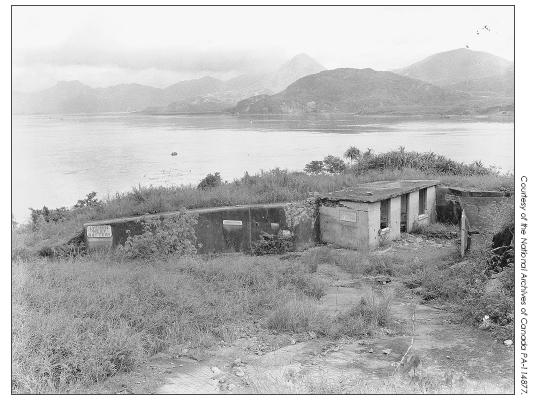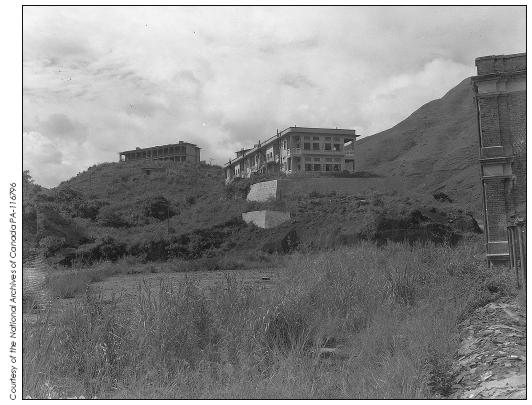Sergeant Gander (8 page)

Meanwhile, the Island Brigade, commanded by Canadian Brigadier Lawson, consisted of the two Canadian battalions and the 1st Middlesex. The 1st Middlesex was a machine-gun battalion from Great Britain that was deployed around the island to man pillboxes, fortified defensive bunkers, and other stationary defences, while the Canadians were assigned positions on the coast, to defend against the expected attack from the South China Sea. The Winnipeg Grenadiers operated on the west side of the island, while the Royal Rifles were on the east. Concerns about this deployment of the Canadian forces can be seen in the December 8 entry in the Regimental War Diary,
17
which states:
The defences on the Island were primarily constructed in anticipation
of an attack taking place on Hong Kong from the direction of the
sea, while paradoxically all tactical exercises, maneuvers, etc., were
always carried out in anticipation of a Japanese attack across the
border of the New Territories and moving southwards to Kowloon
and Hong Kong.
18
After the orders were received to activate the entire garrison, the Royal Rifles proceeded to take up their positions on Hong Kong Island. By 1400 hours (2:00 p.m.) most of the Royal Rifles had been ferried across the Lye Mun Passage separating Hong Kong Island from the mainland, and had dispersed to their positions along the fifteen-mile front across the eastern section of the Island.
19

The initial positions of the Royal Rifles of Canada, Deâcember 1 to 18, 1941.
Battalion Headquarters, HQ Company, and several other small detachments were deployed in the Tai Tam area; “A” Company Headquarters and two platoons were at Windy Gap with one platoon at D'Aguilar Point. “B” Company Headquarters and one platoon were at Stanley View, one platoon was between Mary Knowl Convent and Stanley Bay, while a third platoon took up position at the Y in the road leading to Stanley Village.
Sergeant Gander's “C” Company was held in reserve in the Lye Mun region with three company platoons and four reinforcement platoons. “D” Company Headquarters was positioned at Obelisk Hill with three platoons at Ty Tam Tuk.
20
Several small detachments of the Hong Kong Volunteer Defence Corps, the Royal Scots, the Middlesex Regiments, and the Rajputs and Punjabs were scattered throughout the positions held by the Royal Rifles.
21
Having taken up their defensive positions the British and Canadian troops could only watch and wait for the inevitable arrival of the Japanese.
On December 8, 1941, just after the Japanese attack on Pearl Harbor,
1
the Battle of Hong Kong began. At 4:45 a.m. a British intelligence officer monitoring Japanese radio newscasts heard the following message, “The Army and Navy divisions of Imperial Headquarters jointly announced at six o'clock this morning (Tokyo time), December 8, that the Imperial Japanese Army and Navy forces have begun hostilities against the American and British forces in the Pacific at dawn today.”
2
However, breakdowns in communications meant that not all units were aware of the outbreak of hostilities. An inefficient telephone system, and the fact that the declaration of hostilities was received over the radio at 4:45 a.m. when many in Hong Kong were still asleep, created this dilemma. Unaware of any declaration of war, the administrative personnel of the Royal Rifles, who were still stationed at Sham Shui Po Barracks, were startled by the appearance of planes overhead.Captain E.L. Hurd recorded the scene in his diary:
On the morning of December 8th, strange aircraft were noted
flying over our Barracks, and a few minutes later three planes
returned. At the same time the Air Raid Signal was heard over
Kowloon. This was 0800 hrs. and at the time we had received
no news about hostilities. I was discussing the alarm with Capt.
Thompson, and at the same time noticed three bombs drop from
one plane ⦠We dashed into Capt. Barnett's room, just as the
bombs hit. Some hit in the Jubillee Bld'g near where our officers
were quartered. Another hit still closer, probably forty feet from
where we were taking cover. Two others hit in front of the Ration
Stores near the main gate. There were several casualties in this area
but with the exception of two O.R. of Brigade Staff, they were all
Chinese servants ⦠Fortunately there were no injuries received
here on Royal Rifles.
3
The Japanese bombers released much of their bomb load over Kai Tac Airport, located on the north side of Kowloon Bay, Kowloon, Hong Kong, rendering the facility useless. In one fell swoop the Japanese had achieved air superiority. The pitifully inadequate Royal Air Force stationed there was completely destroyed on the ground, and the nearest RAF station was located over 2,400 kilometres away, in Malaya.
4
On a second pass over Kowloon, the Japanese bombers dropped leaflets demanding the immediate surrender of Hong Kong.
With the achievement of air superiority, the Japanese ground troops marched into the New Territories, the northern most region of the Hong Kong colony, virtually unopposed. As they had been ordered to do by Brigadier Wallis, the forward-based Punjabi contingent commenced the demolition of bridges, roads, and railways, and began their withdrawal towards the Gin Drinker's Line. However, their demolition efforts did little to slow the Japanese movement towards the Island, and by the morning of December 9, their troops were facing the Gin Drinker's Line. By December 10, the Line had been totally penetrated and the British troops were pulling back towards Hong Kong Island. Efforts to slow the Japanese advance were ineffective and General Maltby ordered a general withdrawal. By the morning of December 13, all British and Canadian forces on the mainland had been evacuated to Hong Kong Island.
The Japanese followed up this withdrawal with a request for surrender. It was refused by the British Governor Mark Young, and the Japanese began heavy shelling and bombing of the Island's coastal defences. There were power failures and communications disruptions all over the island, and hundreds of Japanese infiltrators slipped onto the island, creating a pipeline of information to the Japanese commanders about British and Canadian troop movements, ammo dumps, supply depots, pillbox positions, and gun placements.
Sergeant Gander and “C” Company were deployed at Lye Mun. Located a mere 412 metres from the mainland, Lye Mun was an obvious potential crossing point for the Japanese. From December 10â17, the Japanese bombardment of this area was extremely heavy and “C” Company sustained some casualties. The shelling repeatedly knocked out water, electric power, and telephone lines. Organized feeding of the soldiers became almost impossible, since any concentration of men around the kitchen facilities resulted in “heavy and accurate enemy shelling.”
5
The men of “C” Company were also “becoming more reluctant to use the telephone system to announce any proposed movement of men as it inevitably resulted in accurate shelling of the route. The lines were obviously tapped by enemy agents.”
6
Gander couldn't stand the noise and frequently took refuge in the pillboxes, although he did accompany the men on their patrols for snipers. The incessant shelling and lack of hot meals took its toll on “C” Company. “They had been unable to rest either by day or by night” and Major Bishop, commander of the Company, requested that they be taken out of the area, for a period of rest.
7
The request for relief was granted, but unfortunately for “C” Company the Japanese invaded before replacements arrived.
A second Japanese request for surrender was submitted on December 17, and it too was refused in a message that stated: “The Governor and Commander-in-Chief of Hong Kong, declines most absolutely to enter into negotiation for the surrender of Hong Kong, and takes this opportunity of notifying Lieut.-Colonel General Sakai and Vice-Admiral Niimi that he is not prepared to receive any further communications from them on the subject.”
8
In response, General Sakai issued the following order to his staff, “On Thursday night, December 18, Japanese Imperial Forces will land upon the Island of Hong Kong at suitable situations between North Point and Lyemun.”
9
Late that evening, the Japanese launched their invasion of Hong Kong, sending assault boats, landing craft, and steamers across the Lye Mun Passage, the narrow channel of water that separated Hong Kong from the mainland. All three regiments of the Japanese 38th Division were committed to the attack.
At Lye Mun, the Rajputs were the first line of defence, with “C” Company of the Royal Rifles situated just behind the eastern shoulder of the beachhead.
10
However, “C” Company recorded that “between 2100 and 2200 hours there was
Lye Mun Batâtery, showing the Lye Mun Passage where the Japanese crossed. The high point in the centre of the photograph is Devil's Peak.

a continual road race of Indian troops running past without arms in the direction of Tai Tam. No information could be obtained from them, they would only say, âJaps, thousands of Japs.'”
11
As the Japanese began landing on the Canadian-held section of beach, the Royal Rifles laid down heavy gunfire in an effort to slow the approach of the invading forces.
“Now we got our first clear look at the enemy,” Rifleman Sydney Skelton remembers:
Swarms of small, shrieking men in khaki jackets, breaches and
puttees, helmets bearing the single star, long bayonets, automatic

Lye Mun Barâracks, the most northern point held by “C”Company.
weapons. They poured out of the landing barges. Some of them
threw themselves on the barbed wire while the others streamed
over the human bridges. We were on the high ground and we
really peppered them. My Bren was hot. But they kept coming.
I thought, â⦠there's no end to them.' Then the planes came in,
strafing and bombing, and we fell back.
12
Gander joined his comrades in the fight, relying on his own best weapons: his size and a strong set of teeth. Despite the ferocity of the fire fight surrounding him, Gander charged at the invaders, running this way and that, snarling and rearing up on his hind legs. Rifleman Reginald Law recalls, “Gander appeared to hate the Japanese on sight. He growled and ran at the enemy soldiers, biting at their heels. And what amazed us all was that they did not shoot him then and there.”
13
By 0100 hours on December 19, it was clear that “C” Company was in danger of being encircled by the Japanese, and the order was given for them to retire southwards. Casualties were high and the evacuation of the wounded slowed the retreat. An excerpt from the “C” Company War Diary describes the condition of the retreating men:
None ⦠had had a hot meal for five days owing to the destruction
of the cooking arrangements. They had been doing continuous
manning for over a week with no chance to sleep but in weapon
pits. Some would fall down in the roadway and go to sleep ⦠it
took several shakings to get them going again.
14